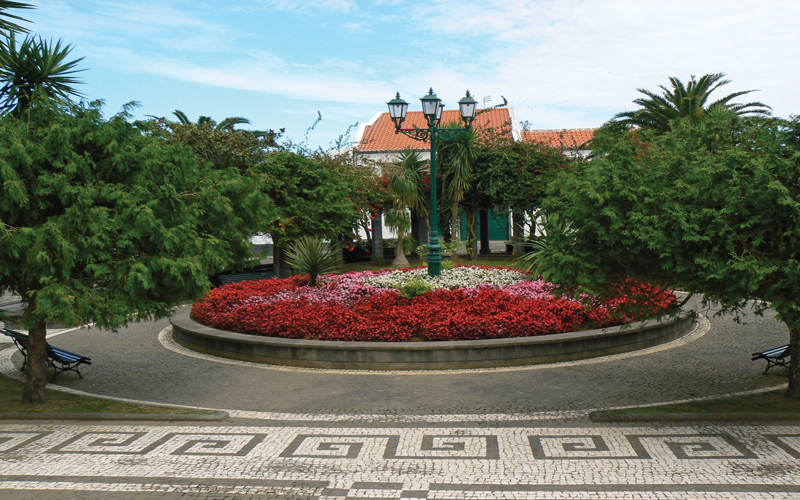Getting Lost in the Azores
When people tell me it’s impossible to get lost, I inevitably prove them wrong.

On the island of Saõ Miguel, in the Azores, I discover that going astray brings pleasant surprises.
At one unscheduled stop, Ponta da Madrugada (about 1,500 feet above sea level) verdant mountains slither down to the sea. Waves thunder against its steep cliffs.
A group of Azoreans choose this dramatic backdrop for their Sunday outing. They fill the air with singing, clapping, accordion playing, castanets and an instrument that looks like a broken abacus. One dancing lady grabs me and before long, I am one of them. Well, sort of. Being a klutz, I am mostly smashing my partner’s feet. “Obrigada” (thank you), I say to the lady who chose me. She puts her hand on her heart, smiles and says, “nada.”
Everywhere we go, even if we are lost, we are surrounded by friendliness. No one is a stranger on Saõ Miguel Island The weather -no hurricanes and year-round temperatures between 55° and 80°F- is as gentle as the people. These very affordable Portuguese islands stretch across the mid-Atlantic
Clouds hang so low over Saõ Miguel that they become one with the verdant volcanic landscape and the sea. Crater lakes and mineral springs are everywhere as is a rainbow of flowers. Multi-colored hydrangeas border the roads – some are as blue as the expansive sky.
“Flowers are a gift of God, so we use them to ornament the road,” says Cidália Costa, then the Regional Director of Tourism in Furnas.
Exploring
Small towns have twisting cobblestone streets, pastel painted homes and whitewashed churches. I figure the narrow streets are probably the reason people drive small cars. Our rental, a Renault Clio, is not much longer than my 6’1” husband is tall.
We explore the quaint capital of Ponta Delgada on foot. Streets with mosaic sidewalks stretch out from the modern waterfront like threads in a spider web. Two big churches dominate the area: Church of Saõ Paulo and the Main Church. Azorean churches all look similar- whitewashed walls, brown trim, bell towers, an imposing façade and ornate doors. Everything else is subtle. Shops don’t have flashy signs. You have to peer in the windows to see what they are selling.
At Restaurante Saõ Paulo, hard goat cheese, Azorean black sausage with pineapple and wine are mouthwatering. The island’s local vinos like Terras de Lava are delicious.
Someone else does the driving, so we don’t get lost on our outing to Ribeira Grande, a quiet place with small shops, beautiful gardens and stone bridges. The Museu da Emigração Açoriana (Museum of the Immigrants) chronicles the Azorean Diaspora.
The Diaspora started in 1857. Azoreans settled mostly in Massachusetts. In the 1960s and 70s, after Velha Volcano erupted, more came. Today the volcano flourishes with hot springs, waterfalls, greenery and Lago De Fogo, a beautiful crater lake.
Natural Wonders
To reach the 21st century, the island is a work in progress. Road construction is commonplace. But it isn’t all bad. A wrong turn lands us at Lagoa de São Brás, a serene crater lake at the dead end of a steep, bumpy mountainous road (not easy to do when you are riding in a car that weighs about 10 pounds). The only living things here are cows. It’s a solitary wonderland.
But we don’t tarry. There are many more wrong roads to explore. Finally, we spot the rising steam of Furnas’ fumaroles. This town’s scenery is over-the-top.
Behind our hotel, sits the Terra Nostra Garden. A thermal mineral spring, with waters said to be a cure-all, pours from spouts into a large pool. We soak in the warm, orangish-colored water and feel rejuvenated. Later, we explore the winding trails around huge towering trees, endemic plants, and flourishing ferns. Even with a map, it takes a while to find our way out.
The town’s fumaroles and cave-like mud holes steam and bubble just like they do in Yellowstone. At night, when they are illuminated, there is a haunting aura about them. Long ago, the Roman Catholics, believed this area
was hell.
These days, locals use the hot soil to cook Cozido, a dish containing chicken, beef, pork, sausage, plus vegetables such as carrots and kale. Containers of it are buried in holes for 6 1/2 hours. A visit to the lake at about 12:30 finds men digging up the pots for delivery to local restaurants. Cozido must be ordered a day in advance, but it is well worth the wait.
Down the road from Furnas, past fairy-tale-like towns, is the sleepy town of Nordeste (pronounced nor- desh). The hamlet’s square is bursting with blooms. To get better pictures, we wander to the bottom of an old bridge with seven arches. Two young families ask us to take their pictures – the guys are holding little whiskey bottles which they want to be the main focus. They are chatty and funny.
Taking a different route back to Furnas, we discover Miraduoro da oe-te Que Suas, a lovely little national park on side of the road. One side has a waterfall flowing into a pool surrounded by flowers. Across the road a small river trickles past a water wheel.
Saõ Miguel Island fills our stomach with tasty vittles and vinos and our eyes with flowers, verdant volcanoes, lakes, the crashing sea, and lots of grass-munching cows. Getting lost has its advantages, because of the stunning landscapes and friendly people we found along the way.
www.visitportugal.com/en/destinos/acores




